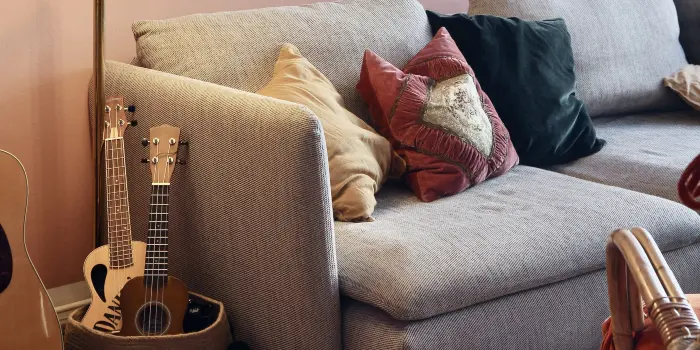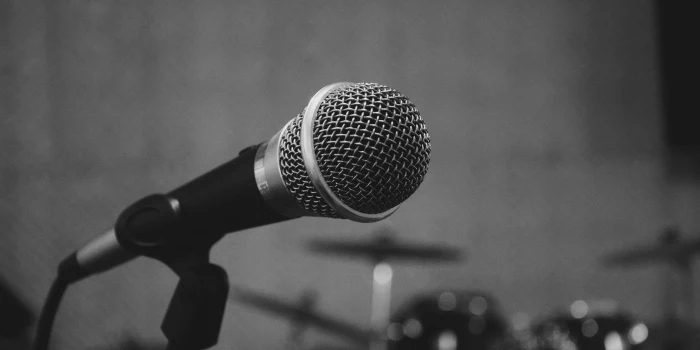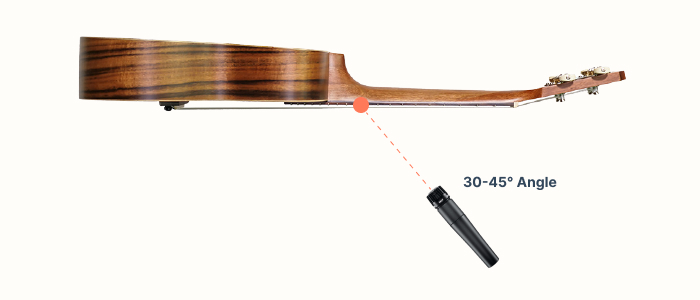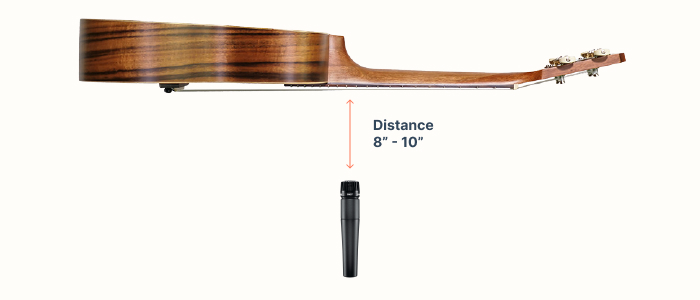If you want to know how to record a ukulele in your home recording studio properly, you are in the right place.
There might be a time when a song requires a different instrument like the ukulele for additional flavor. And it’s good to know the best way to record it.
Recording the ukulele uses almost the same techniques as other acoustic instruments like an acoustic guitar. But there are some small differences.
In this step-by-step guide, you will learn the best way to record ukuleles in your home studio with microphones.
What’s The Best Way To Record Ukulele?
There are numerous ways to record your ukulele. If you own an electric ukulele, you can just plug it into your audio interface and start recording it like any other electric instrument.
But this guide is about acoustic ukulele recording. Here you will learn how to record a ukulele with microphones. And there are different things to consider before you start the recording session.
Let’s start and learn how to create a good recording environment, how to choose mics, place them correctly, and start recording.
1. Avoid Any Noise
The first thing you should do before starting to record a ukulele is to eliminate any noise that may interfere with your recording. You want your recording to be as clean as possible.
In order to capture even the faintest sounds, it is essential to have a noise-free environment when using a microphone. Thus, it is crucial to ensure that your surroundings are meticulously quiet and devoid of any disturbances.
First, of course, your room must have a good recording environment. You need to treat your room acoustically. The recording will be much better when the room is properly treated.
Next, make sure there is no outside noise coming into your room. If you have an air conditioner in your recording room, turn it off. Also, turn off anything that makes even a small sound or noise.

Also, choose a soft chair or couch to sit on while you are playing and recording the ukulele. If a chair has some cracking or any other sound, a microphone will pick it up and the recording won’t be as clean as it should be.
Lastly, it is important to don attire that is free of any rough textures. Clothing has the potential to generate unwanted sounds during your performance, so it is advisable to steer clear of such distractions.
So, the goal is to eliminate any type of sound while you are recording your ukulele with microphones. The microphone must pick up the ukulele sound as cleanly as possible.
2. Choose A Good Ukulele Microphone
A very important gear when you record a ukulele is the microphone. The quality of sound is heavily dependent on how you mic the ukulele. The quality of the ukulele is also important but you can get a good sound with an affordable ukulele if you have a good mic.
You need to choose the best recording microphone you can find. You don’t need to buy an expensive microphone. Many affordable mics are great for recording acoustic instruments.
Also, you have to consider the type of microphone you want to record the ukulele with. You can choose between dynamic and condenser microphones. Play some ukulele songs and test how it sounds with a microphone.
Dynamic Mic

The first and perhaps the most popular microphone choice would be a dynamic mic. Dynamic microphones are great for acoustic instruments and capture sound perfectly.
Also, dynamic mics are great because they produce more focused sound. Because dynamic microphones have a small diaphragm, they will capture the instrument’s sound depending on the placement.
Additionally, dynamic mics don’t require preamp or phantom power. So, you can just plug it into your recording device and start recording immediately.
One of the best dynamic microphones for recording purposes is Shure SM57. It’s classic, affordable, and the most used microphone in the recording world.
Condenser Mic

On the other hand, condenser mics are great for different reasons. Because they have a bigger diaphragm, the recording won’t be as focused but it will have more breathing space.
Your recording would have more air, space, and natural reverb. Condenser mics will capture the room’s sound better than dynamic mics.
However, condenser mics require phantom power in order for them to work. So, make sure your recording device has phantom power before starting to use a condenser mic. Audio-Technica AT2035 is a great condenser mic for recording.
All in all, both types of microphones are great to record the ukulele. The choice is yours and it depends on your preferences.
3. Mic Placement For Ukulele
After you choose the recording microphone for the ukulele, it’s time to work on mic placement. A good placement for a microphone is critical in a recording. The sound quality is heavily dependent on it.
Different mic placement techniques exist and you can create your own. But there are some good mic placement practices for recording acoustic instruments. And ukulele recording is very similar to acoustic guitar recording and its mic placement methods.
Mic Placement
When you record a ukulele, the first thing you need to do is to place the microphone in the proper place. This will determine the sound quality of the instrument.
A good practice is to point a microphone diaphragm to the 10th or 12th fret of a ukulele. And it should have a small angle. About 30° to 45° is a good angle for the microphone.

This way microphone will capture the most natural sound. Because it will be far from the soundhole, you will avoid too much low frequency and also retain mid and high frequencies.
However, depending on your ukulele, you can adjust the placement and place the mic near the soundhole, but the 10th or 12th fret method will work for most instruments.
Mic Distance
And the second thing in recording a ukulele you should consider is the distance between the mic and the ukulele. A microphone shouldn’t be too far or too close. You need to find the best spot.
In general, 8″ to 10″ is the perfect distance between a microphone and a ukulele. The sound will be more natural and it will also have some reverb and breathing air.

Of course, as in any acoustic instrument recording, you can tweak it and find a better-suited distance for you. Because every instrument is unique and they have a different sound.
But in general, this is a great distance. Also, the microphone won’t interfere with your playing.
It’s important to test different mic placements before starting recording. Record some demo parts and hear how it actually sounds. Adjust mic placement and distance until you are satisfied with the sound.
4. Start Recording
Now it’s time to start recording. Plug everything, create an audio track in your favorite DAW, hit record, and start playing.
Play the song from start to finish and record it. This way the song will be more natural and cohesive.
Try to make as few mistakes as possible. If you make a major mistake, start over. But don’t stop for minor mistakes. You can edit them later.
After you finish recording the ukulele, listen to it and hear how it sounds. If you don’t like the sound, try to make changes to the mic placement and re-record your parts.
Double Track Your Ukulele (Optional)
Double tracking the ukulele is not mandatory but it can create a more interesting and rich sound. If you double-track the ukulele, you will have an option for panning and you get a stereo sound.
Double tracking means when you record the same part twice. Then you can pan each instrument on both sides and you get a stereo sound.
But when you double-track any instrument, in this particular case, an ukulele, try to use a different-sounding ukulele or a different mic.
What you can do is record one part with a dynamic mic and the second one with a condenser microphone. And you have two different options.
First, you can use the same mic placement but with different types of microphones. Then pan one track to the left side and another to the right. This way you will have a ukulele on both sides. It will create a stereo sound and fill up the space.
On the other hand, you can place a condenser mic far from the instrument to capture the room sound and create a natural reverb sound. But in this case, you don’t pan the tracks.
Instead, you combine the two recordings in one track and blend them. Your dynamic mic track could be the main one and then blend another track recorded with a condenser mic.
Now you will have one ukulele track with a huge sound. The dynamic mic will have a more focused sound and the condenser mic will produce natural reverb. It will add space to the sound.
Conclusion
Ukulele is a great instrument and can add flavor to your songs. Also, it’s a fabulous instrument if you create corporate, royalty-free tracks. Knowing how to record the ukulele properly will make your job easier and more fun.
All you need is a decent instrument, a good mic for recording, and an understanding of mic placement to capture the best sound. We hope this guide will help you to create great ukulele tracks.
